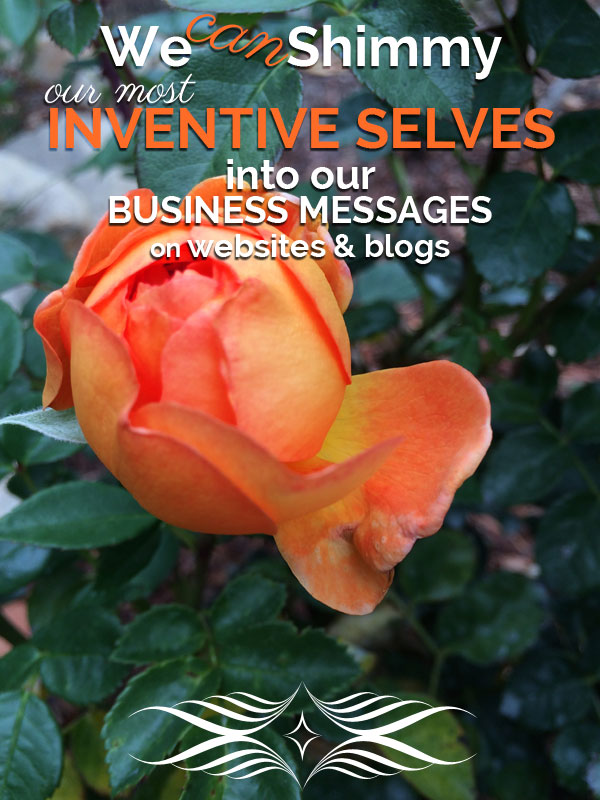Writing Content Truly From You And For Them
Write What They Need [and] What You Truly Care About
How do we shimmy our most inventive selves into the business message container [our website & blog] that we’ve created with purpose for our customers and their needs? It’s the consistently echoing dilemma that small business owners face about writing content. Like a record with a skip, over and over, we puzzle the question; do we focus on writing in a way that fulfills a requirement or do we write what we’re inspired to write about, the things that our business inspires us to write about? The dilemma highlights the disconcerting largish detail that those two things aren’t always aligned.
Can we bring them into alignment? [Tweet “Can we write content in a way that we genuinely feel invested in? “]That exercises our creative muscles, and in turn also reaches back its hand and invites inspiration to flow forward into our business creating that two way street? Can we find what drives us to make that extra effort at excellence? And here’s the tricky part: that also provides our customers with what they need at the same time?
Yes. We can. We should.
Not the easiest challenge to tackle, but how else will the material we write be both compelling and helpful? Inspired and excellent.
We Ought To Look For Ways To Do Just That
The thing is, it really pushes the edges of having (or working for) a business we believe in, when we think about it. Because the sensible necessity is to write for our customers, answer their questions, solve their dilemmas, fulfill their needs but if we go about it halfheartedly we fail on so many levels. So then we’re really not achieving the goal we set out to achieve. Our lack of commitment and conviction will be felt and trust will be diminished. Our information will be less reliable because it won’t be well researched. We won’t be helpful. This is ultimately a shirking of not only our responsibility to our customers but to our business as well. And where do we end up? In the realm of mediocrity.
So then how do we match up what we really care about and can write about with the level of attention and commitment the work deserves with what they [our customers] really care about and need? How do we construct that congruency?
The obvious answer is to invest in work we believe in and have customers who believe in it too. Set it up that way from the start. But it’s obviously not always entirely possible to do that within any time frame much less from the start. So let’s see if it’s possible to put that option aside for the sake of realism and the conversation.
[Tweet “How do we avoid funneling down into the swirling vortex of less-than-important? “]The thing is, once we ask that question, we see that we really can’t put the option of work we’re invested and believe in utterly to the side. The “option” that represents the dream of better things will find us even if we try to scramble away from it. So we have to find a way to incorporate that ideal into a possibly less than ideal scenario.
(Oh – and if you’ve been wondering at all why I chose a photo of a rose bud for the image on this post, I’ll tell you in a moment.)
There Is Always Hope
I like to believe that there is always something to dig our teeth into, to love and believe in no matter the circumstance or the nature of the work. It may take some effort to locate, but it’s there in the small things if it’s not in the big ones. Maybe it’s something we take for granted, don’t notice anymore because we’ve become habituated to the work we do. But…[Tweet “When we take the time to peel back the layers as we’re looking for it, there it will be.”]
One of the biggest draws in the pull towards mediocrity is when we see that kind of less-than-excellent work we are trying to sidestep get a lot of attention on social media and our attention is on the wrong values. It can look to us like the lowest common denominator material is somehow appreciated more than our own diligent efforts. And the result of observing that can cause some people to try to find a way to duplicate the seemingly magical something. Thinking that it’s what will put them over the hump of being invisible, they try to become facile at creating that kind of vacuous content. This is a misguided path.
My Rose Example
I have a passion for my roses but I’m not a fanatic when it comes to their care. We border on an attitude of ‘survival of the fittest’ around here because we don’t want to use chemical sprays and our plum trees cast too many late morning shadows on them, not to mention the drought issues. We do manage to prune them every year even if a bit haphazardly. But I love my small rose garden as if it were thinking and breathing the way we [and our dogs] do.
Much to my own delight, we bought some new rose bushes this season. It had been awhile since we’d done that. I went to the nursery- the one with the Rose Field strewn with hundreds of varieties and wandered, taking in the fragrances and seeking out my favorite colors while keeping an eye to the word “hardy” in the descriptions. I ended up with a new climber and three new bushes one of which is an old English David Austin (named Pat Austin). A very exciting addition for me because I’ve always wanted an old English rose and the last one I had didn’t work out.
Little did I know it would provide me with a social media post that in a converse way, perfectly demonstrates the value of value. It also, as a bonus, illustrates what’s wrong with peoples’ thinking about social media counts and how value is determined. Including, sometimes, my own because we’re all vulnerable to the shiny of numbers from time to time.
When its first bud appeared in some glory the other day (May 23, 2015), I took a photo of it and posted it on Google Plus with just a short, happy description of what it was. One among the yawn producing sea of flower photos on social media. It was an easy, almost throwaway post, little effort, yet sincere. In fact, I pulled the image over from iPhoto and was so casual about it, I even forgot to rename the file with my name included. But it’s a pretty nice photo. [Tweet “I’ve used it for this post so you can see. That bud was glorious.”]
It’s So Ironic
What I expected from that post was basically nothing. I just wanted my friends to see the pretty bud on my new rose bush. What happened was completely unexpected and actually felt like cheating. So little effort and more plus one’s on a post than I’ve ever had – by a lot.
But I’ve used the photo here for other reasons. It seems like a visual and contextual oxymoron of sorts, to me. There’s something strange and contradictory I can’t quite put my finger on. The photo that was empty of effort, depth or exploration and gained me all those meaningless plus one’s is now the same photo I am attaching to this article that matters to me very much and I’ve put considerable time and energy into. But this article is highly unlikely to get anywhere near the same number of plusses. OR perhaps, if it’s in a humorous mood, the photo will still push that clout. But I doubt it. It makes me laugh. That irony.
I’ll mention now, with no over-embellishment that in the serendipitous way I love about Google Plus, I was formulating the ideas for this article, gaining momentum due to the rose post, when yesterday, I read a terrific short piece from Danny Brown, called The BuzzFeed Economy and the Chase for Social Proof, that pushed me over the edge of my own inspiration to complete my thoughts.
Here’s The Important Part
Ironically, the “approval” my rose post has gotten is completely worthless because with the exception of a handful of some of my favorite engagers there is very little engagement. I took a look at who was giving it their stamp of approval and it was absolutely clear there is no potential for new connections or deepening relationships and certainly no potential clients among the long list.
The Experience Re-Showed Me A Few Things
It’s pointless to try to reproduce a post like that. It’s wasteful and foolhardy to try to manipulate content (simple photos or website content or blog articles) to please the masses at the risk of compromising quality and depth. Creating content that is carefully tended, inspired by real needs and interests will serve us better in the long run. As Danny might say, because it’s “not lazy”.
There is no point in trying to achieve a high stat number on a post unless it comes with meaningful value to you and your business. And your customers. This is precisely what I work with our clients on when we begin to articulate what the content will be on the website we develop for them. And again when the envisioning for their blog sets in. I help them to peel back their own layers to get at the good stuff that lay waiting to be brought into some light. The things that inspire them in their work, their company why and why they are there in the first place, who are they helping and why and how, what that means to them and their customers.
The absolutely most important thing is to write about the things that make you shimmy with delight and that will provide as much useful material to your clients as you possibly can. Find your way to shimmy into position for that.
Here’s my celebrity bud one day later (May 24, 2015):

SUBSCRIBE & Receive Blog Notifications Of New Posts:
* Don’t miss any of our blog posts! Subscribe at the top right of this page.
Google Plus Post Notifications:
* Would you like to be included in my Google Plus Notification Circle?
If you would, please visit the invitation and let me know in the comments with a +mention of my name. Thanks!
Photo Credit: Gina Fiedel
We’ve recently installed Google+ Comments.
If you’d like to leave a COMMENT- PLEASE CHOOSE:
‘W’ for our WordPress commenting system,’G+’ for Google+, or ‘F’ for Facebook






